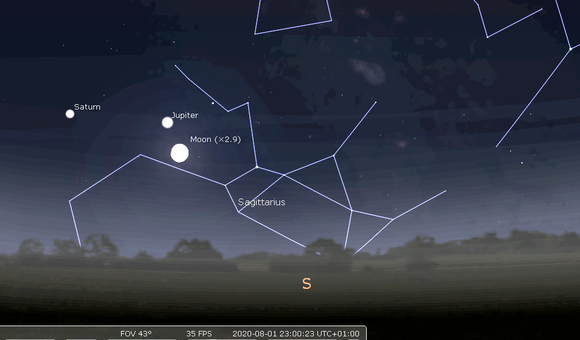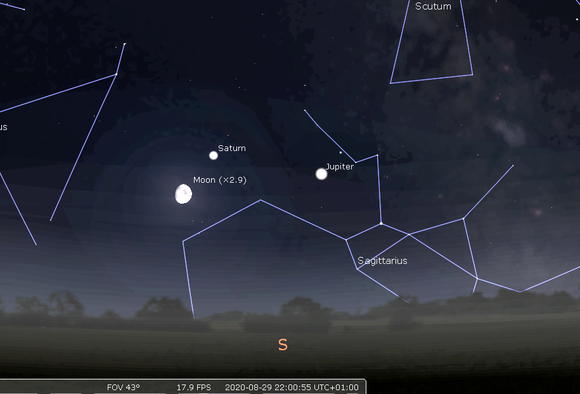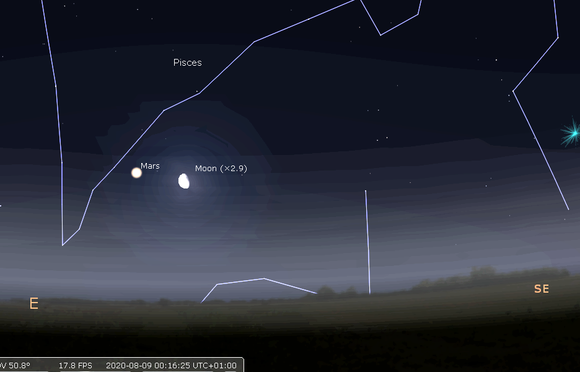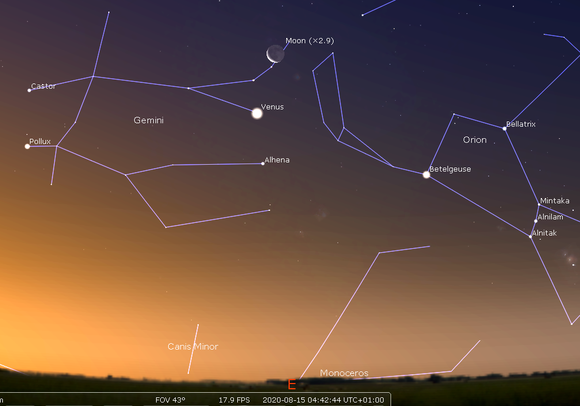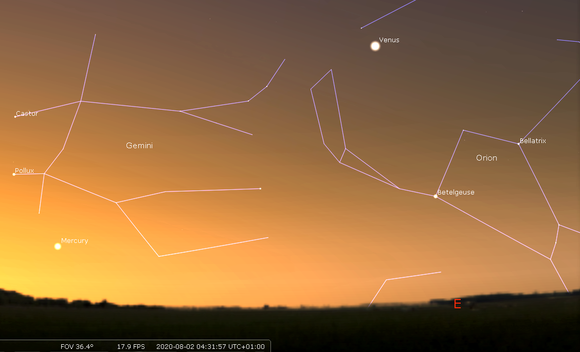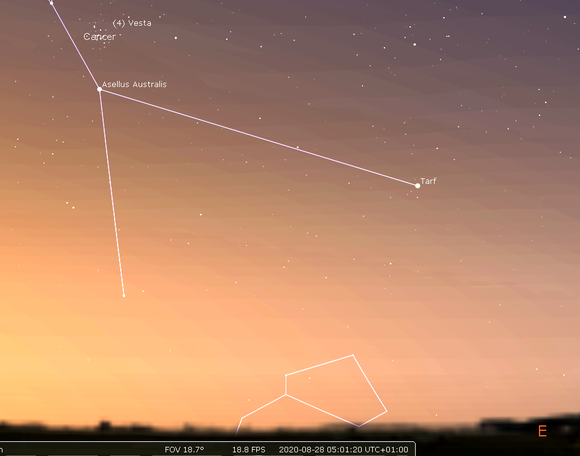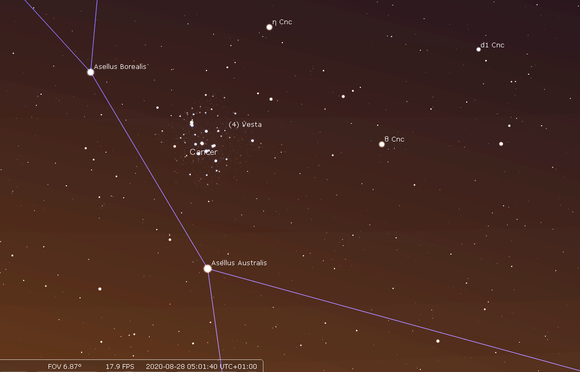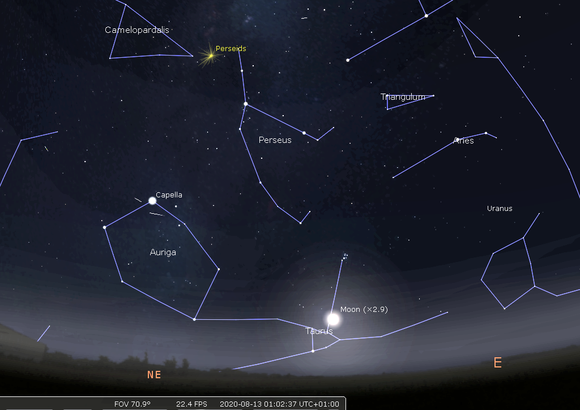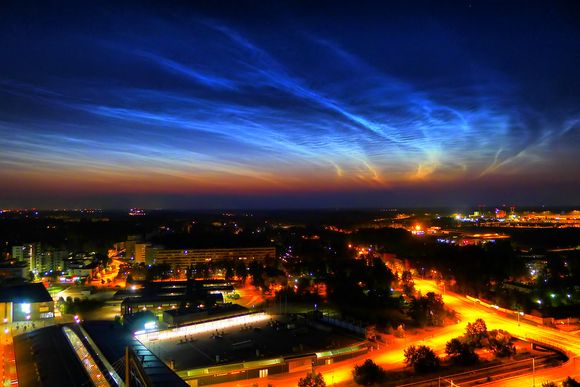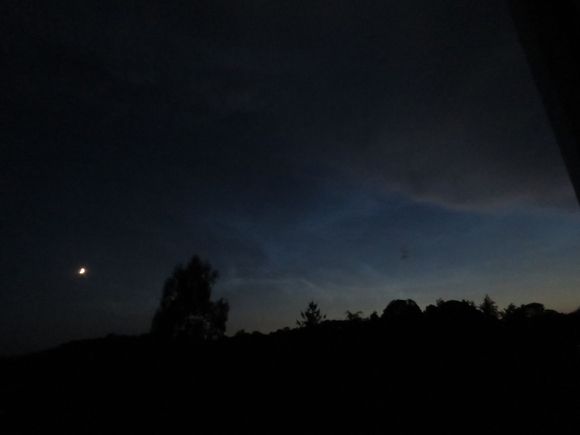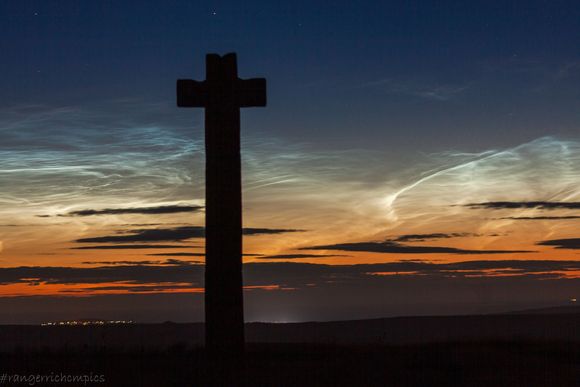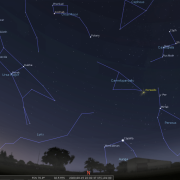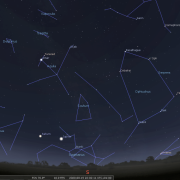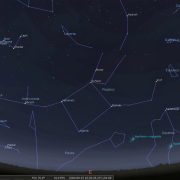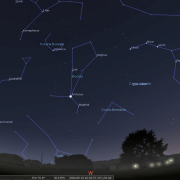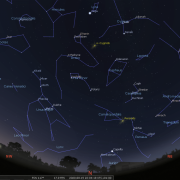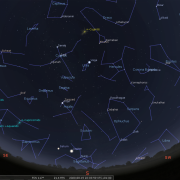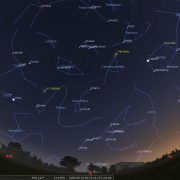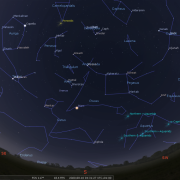In this month's Sky Notes:
Planetary Skylights
Jupiter and Saturn reach Opposition


Having both reached opposition last month, Jupiter and Saturn reign supreme in the evening sky. Jupiter is the far more conspicuous, a brilliant beacon low to the south, with Saturn trailing in its wake, fractionally higher and several degrees behind. Jupiter is a rewarding object to scrutinise with a telescope, or even binoculars. Look for the banding across the disk and the attendant Galilean moons, which offer a different configuration each night.
Galilean Moon Shadow Transits (ShT) and Great Red Spot Visibility (GRS). All times BST
- 1st GRS visible from 21:30h.
- 2nd Io ShT from 21:15-22:00h.
- 3rd Europa ShT from 22:15h & GRS from 23:15h.
- 4th GRS until 22:15h.
- 6th GRS from 01:15h and again from 21:15h.
- 7th Ganymede ShT from 23:40h.
- 8th GRS from 22:30h.
- 9th Io ShT from 21:45h
- 11th GRS from 00:15h & Europa ShT from 01:15h & GRS from 21:00h & Calisto ShT from 21:00h. 13th GRS from 22:00h. 15th GRS from 23:15h.
- 16th GRS until 22:00 and Io ShT from 23:45h.
- 18th GRS from 00:45h & again until 23:45h
- 20th GRS from 22:00h.
- 23rd GRS from 00:15h & again until 23:00h. 25th Io ShT from 20:30h to 22:30h & GRS from 21:30h.
- 27th GRS from 23:00h.
- 28th GRS midnight & Europa ShT from 20:15 to 21:45h.
- 30th GRS from 00:45h and again from 20:30h
Although fainter than Jupiter, Saturn is nevertheless still prominent to the naked eye and is currently visible at Mag + 0.2. Of course, to view the beautiful ring system a telescope is required, but the orientation is still favourable and very modest instruments will suffice.
You may also note Titan, Saturn’s largest moon, which resembles a bright, but obvious speck nearby Saturn. In a effort to counteract the low altitude of Saturn (and Jupiter), and hence the usually inferior seeing, try to observe Saturn when passing through the south meridian at its highest, which will be approaching midnight by mid August.
 Stick with it, as moments of clarity will reward your patience. The Moon passes below Jupiter and Saturn on the 1st and 2nd respectively and again on the 28th and 29th.
Stick with it, as moments of clarity will reward your patience. The Moon passes below Jupiter and Saturn on the 1st and 2nd respectively and again on the 28th and 29th.

Mars rises in the ESE and continues to make inroads into the late evening sky as we head through August, rising shortly after 23:00h at the start and well before 22:00h by the end. With its distinct orange hue conspicuous to the eye, the red planet is gaining in brightness and size, from magnitude -1.1 to -1.8 and from 15 to 19 arc seconds, over the course of the month.
With opposition not until October, Mars is already becoming very noticeable, reaching a very respectable altitude of 45 degrees above the south horizon in the early morning hours by the end of August and therefore less prone to the turbulent airs above the horizon. That said in the eyepiece Mars will still look surprisingly small, especially to the novice, but one has to remember that Mars is a small world, sitting between Mercury and Earth in size.
In the coming months surface detail should become more apparent; however the chances of obscuring Martian dust storms will also increase as opposition approaches.
Mars is still moving in prograde motion (west to east) through the SE portion of Pisces, but this is slowing and it will shortly hit its first stationary point before starting its retrograde motion. The waning moon passes below Mars on the 8th.
 Both of the outer gas giant twins are visible in the very late evening/early morning sky. Neptune resides in Aquarius a couple of degrees to the left of Phi Aqui. At Mag +8 it is visible in binoculars, although a telescope is required to reveal is tiny blue grey disk. Neptune lies due SE at midnight on the 17th.
Both of the outer gas giant twins are visible in the very late evening/early morning sky. Neptune resides in Aquarius a couple of degrees to the left of Phi Aqui. At Mag +8 it is visible in binoculars, although a telescope is required to reveal is tiny blue grey disk. Neptune lies due SE at midnight on the 17th.
 Uranus lies in Aries, but near the border to Pisces. It lies half a degree SW of 29 Arietis. At mag +6 it is easily within range of binoculars, but to reveal the very small ghoulish green disk a telescope is required. Uranus lies due east at midnight on the 26th.
Uranus lies in Aries, but near the border to Pisces. It lies half a degree SW of 29 Arietis. At mag +6 it is easily within range of binoculars, but to reveal the very small ghoulish green disk a telescope is required. Uranus lies due east at midnight on the 26th.

Venus reigns supreme in the dawn sky, a brilliant Mag - 4.5 object. It actually passes through the northern part of Orion from the 6th until the 13th when it enters into Gemini and reaches its greatest western elongation from the Sun:-some 46 degrees. By then it will display a 50 percent phase. Look for it low in the ENE from 02:30h onwards. On the 15th a waning crescent moon lies above Venus.

Mercury also resides in the dawn sky, but only for the first week of August before departing once again. Look for it very low above the ENE horizon between 04:15 - 04:30h. Use binoculars to pick it out of the twilight if you cannot spot it with the naked eye.
Elusive Mercury also pops into the July dawn sky, although it is not the best of apparitions’. Start looking on the 19th when just after 04:00h a very slim crescent moon lies above left of Mercury. You will require a flat, unobstructed NE horizon to spot them as they are just a few degrees above it. By the end of the month Mercury will be a little higher, but considerably brighter. View around 04:30h just above the ENE horizon and you should spot it with the naked eye fairly easily.
Planetathon - all in one night!
Here is a nice challenge, for the first few days of August all seven planets may be observed in one night. This scenario all hinges with Mercury, which realistically is only readily visible very low in the east until the 4th.
Given clear skies start with Jupiter and Saturn in the evening, both easy targets to view from 22:00h. Distant Neptune will be best placed from midnight in the northeast quadrant of Aquarius. (see finder chart) You will require binoculars, or better still a telescope, to spot it. Uranus is a little brighter than Neptune and can be identified in binoculars. Look for it in Aries (see chart) (half a degree south of 29 arietis) around 02:00h. Venus will be visible by 02:30h and finally Mercury can be spotted around 04:30h. If skies are clear and you fancy a challenge and have the time, give it a go!
Vesta Heads for the Honey Pot
Here’s another observing challenge, but given clear morning skies around 05:00h on the 27th, 28th, 29th and 30th, it should be achievable and rather satisfying. Over the course of these dates the minor planet Vesta (4) edges closer too, and then steals right through the heart of the Beehive cluster (M44) in Cancer. The faint stars of the giant crustacean will be rising low into the ENE sky – lower left of brilliant Venus. At Mag +8.5 Vesta will be visible in binoculars, just a little fainter than the majority of the beehive cluster members. If you can view on consecutive mornings you should be able to spot the ‘interloper’ ie Vesta in the hive. View from 04:45 - 05:15h
Meteors

The Perseids are one of the more reliable meteor showers, composed of debris deposited over thousands of years by the periodic comet Swift Tuttle. It is various strands of this debris which Earth encounters each August, giving rise to the eagerly anticipated shooting stars, undoubtedly the most widely observed by the general public.
Perseid meteoroids penetrate the upper atmosphere 60 miles (100km) above us at speeds of 43miles (73km)/second, interacting with atoms as they do so, before becoming ionised and releasing a packet of light. It is this brief luminous flash we call a meteor. Particularly bright examples leave behind persistent ionisation trails in their wake, the classic shooting star. The radiant of the shower: the location in the sky from which the meteors appear to emanate, lies within the constellation of Perseus, which in August is rising in the north east during the evening. Perseid activity is highest from Aug 8th-15th reaching a peak normally on the 11th/12th.
Prospects this year, although not ideal, are better than last year and given clear skies a respectable number should be seen if you observe at the optimum time.
The peak falls during the afternoon of the 12thwith a waning moon rising after midnight on the 13th. Therefore the ‘optimum period’ will be 23:00h – 01:00h on the night of 12 /13th. Observing the night before will be more challenging with moonrise earlier and a slightly brighter lunar phase, but you could still witness really bright examples. Under ideal conditions the zenith hourly rate (ZHR) for the Perseids is typically 80-100, but expect no more than a quarter to a third of this during the ‘optimum’ widow period.
Noctilucent Cloud Watch
25-Jul-2018 at 21:10h: Nocilucent Clouds over Helsinki, Finland, by Timo Newton-Sys.
There have been a number of low level displays of Noctilucent cloud throughout July. These have chiefly been visible around midnight low to the north horizon, but nothing really startling. Perhaps the displays on the 13th and 20th were the most pleasing to the eye. (see images) Normally as we head into August sightings of Noctilucent cloud tend to end, but it has been a strange year so don’t rule anything out.
Member Images of Noctilucent Cloud
Additional Image Credits:
- Planets and Comets where not otherwise mentioned: NASA
- Sky Charts: Stellarium Software
- Comet picture: in-the-sky.org
- Log in to post comments

